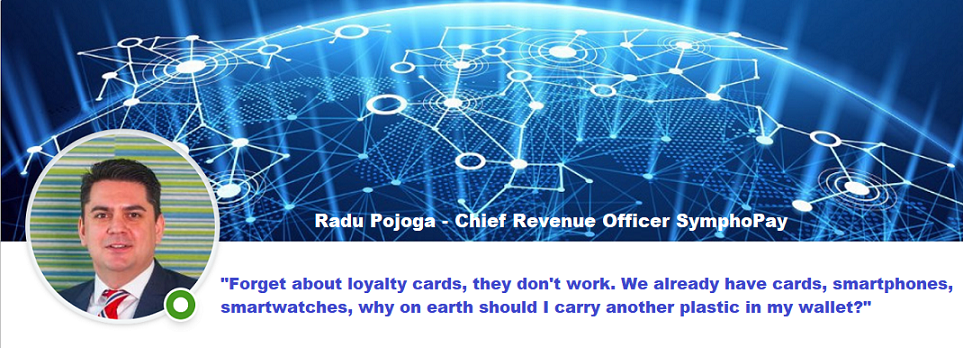
An article recently published by Radu Pojoga – Chief Revenue Officer (CRO) at SymphoPay.
Money transfers were part of my professional life over the last 10 years. As Head of Key Partnerships for Southern Europe in MoneyGram, connecting banks and partners was not only challenging but also satisfying because we helped connecting family and friends around the world by providing a convenient and reliable financial connection for life’s essentials and daily needs.
Recently I have become more interested in what’s happening at the end of the money transfer chain: when money is used for what they are supposed to: shopping. It was right in the moment when I realized that the payment process is the single moment when banks, merchants and consumers interact altogether.
Looking forward at the payment industry, while streamlined in online, it’s still facing many challenges in the traditional shopping channels like brick-and-mortar shops. It starts with increasing pressure from consumers towards the merchants, while the merchants overload the banks with requests for structured information, flexible settlement, easy reconciliation, seamless integration, installments etc in order to increase customer experience.
As the payment’s universe expands, customer experience is becoming the prime competitive differentiator*. Consumers feel a desire to reduce or eliminate friction in the shopping process, forcing merchants to improve it by improving processing and requesting more and more facilities from the banks.
User Experience Will Be Paramount
Have you ever traveled with UBER? Not having to worry about paying, only enjoying the ride and hoping-off waving good-bye. Same at Amazon Go store, they have raised consumer expectations by offering seamless shopping experience. traditional shopping channels must upgrade in order to offer experiences that are just as rewarding.
Point-of-Sale Analytics Will Become Even More Advanced
Understanding payments data will help merchants enhance customer experiences and drive loyalty initiatives. Merchants can use payment data to understand their customer base using metrics like visit frequency, location traffic and average spend. This can be used to identify frequent customers and ensure an appropriate level of service and interaction with these loyal customers. Improving the customer experience by using data-driven insights should be a key initiative for every retailer. They must put customer insights into action within the “hardwiring” of retail practices—pricing, promotion, assortment, adjacencies, new products, the checkout experience and so on**.
Loyalty means investing in relationship
Nearly 60 percent of global respondents said that loyalty programs (marketing programs that reward members with purchase incentives) were available where they shopped, and of those, 84 percent said they were more likely to visit those retailers, according to a new study by Nielsen***.
Having said that, „loyally to customers is when we understand them to a level of detail that ensures that we remain responsive to changes in their behavior, relevant to ever-changing customer needs and rewarding in the way we treat customers.”**. In other words, just forget about loyalty cards, they don’t work. We already have cards, smartphones, smartwatches, why on earth should I carry another plastic in my wallet (if I still carry one)?
Different Worlds, One Goal: Happy Consumers
Traditionally, there are different worlds that collaborate in order for payments to happen: merchants that need to adapt to ever-growing consumer shopping behavior (think of Gen Z consumers becoming nowadays young adults and starting to influence the way we consume), banks who are still conservative due to regulation failing to respond to merchants’ many demands, despite initiatives like PSD2 and fintechs, a new actor who started adding value in this chain.
One of the megatrends in future of payments identified by Accenture speaks about: „Collaboration will make the payments fintech landscape unrecognizable in a decade. Fintech companies are more willing to work with traditional providers. […] A symbiosis of very different organizations with complementary strengths.”
When talking about banks, their organizational structures and risk tolerance do not naturally enable agile innovation. Therefore, fintechs and banks are better together than they are alone, becoming, in fact, the new disruptors, the former being flexible, technologically ready and innovators while the latter leveraging reputation, infrastructure and client base to scale.
What’s Next?
A few months ago, while still documenting on the subject, I met Daniel Nicolescu , Founder & CEO of Symphopay, a visionary fintech company with proven results on growing the engagement rate of the banks and merchants with their customers over the card payment infrastructure. We remained in contact over the last months and constantly shared ideas around the subject.
I truly believe that the technology is reshaping both retail and finance and I realized that I want to be a part of this revolution. Therefore, I decided to start a new chapter in my professional life and I am proud to announce my joining Symphopay Sas their Chief Revenue Officer.
Resources:
(**) https://www.winsightgrocerybusiness.com/operations/so-many-loyalty-cards-so-little-loyalty
Banking 4.0 – „how was the experience for you”
„To be honest I think that Sinaia, your conference, is much better then Davos.”
Many more interesting quotes in the video below: